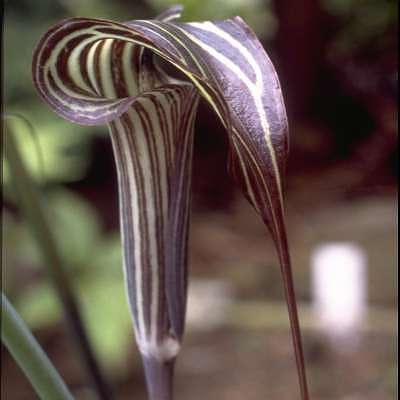
Arisaema ciliatum

Arsiaema dracontium

Arisaema triphyllum
Arisaema
 Arisaema ciliatum |
 Arsiaema dracontium |
 Arisaema triphyllum |
All photos by Paul Christian. Used with permission.
Common names:
Jack-in-the-Pulpit, Green Dragon, Indian Turnip, Dragon Root
Author: Stella Marie Schultz
Permanent E-mail Address: stelstar76@aol.com
Class E-mail address: 350schultz@dial.pick.uga.edu
Higher Taxon: Family Araceae (Arum)
Table of Contents
Arisaemas are a distinctive group that can easily be distinguished from other species. They may grow from a "tuberous rootstock, usually a rounded or blunt bottomed tuber" according to "The Genus Arisaema". They have only 1-3 leaves, though they may appear to have more. The leaves tend to have leaflets or be palmate. Arisaemas bear only one flower per plant. The reproductive structure has a spathe," a convolute tube that surrounds and curves over the spadix"("The Genus Arisaema"). The spadix is a long and narrow structure that is held within the spathe. They also have "brightly colored berries in a conical structure" ("The Genus Arisaema") that appear late in the growing season.
According to "The Genus Arisaema", there are "more than 190 known species of Arisaema, but the number increases as more Asian species are discovered and added. Only 2 species, Arisaema dracontium and Arisaema triphyllum are found in Georgia. A complete species list can be found here.
The 2 species found in Georgia, Arisaema dracontium and Arisaema triphyllum, can be easily distinguished from each other and from other species. Arisaema dracontium has an extremely long spadix that protrudes from the spathe. Arisaema triphyllum has a much shorter spadix that the hood of the spathe folds over. According to Radford, Ahles, and Bell, if the plant has 7-15 leaflets or leaf segments, it is a dracontium. If the plant has only 3 or, rarely, 5 leaflets or leaf segments, it is a triphyllum. Further separation and identification of species in Arisaema can be found in the Manual of the VascularPlants of the Carolinas (Radford et al, 1968).
According to "The Genus Arisaema", the word Arisaema is "derived from the Greek words Aris or Aron, meaning Arum, and haima meaning blood. Here the word haima means kinship. The combined words mean 'akin to Arum'". The genus is pantropical in that its species are found both in temperate and tropical regions. The largest concentration of species is found in Asia, especially in the Himalayas, but there are also species native to North America. Time Life says that "many species are now being introduced to gardens around the world". The source further says that many species "grow wild in the East from New Brunswick and Quebec to South Carolina, and in the Midwest from Manitoba to Missouri and Kansas" (Time Life). Most species are woodland plants that grow best in moist soil incorporated with lots of leaf mold and humus. These plants bloom during late spring or early summer. "Arisaema" suggests that "most can be grown out of doors, in light or dappled shade". Yet, most of these plants do not perform as well in pots as they would in soil. "Containment in pots limits their growth, starves them of nutrients and exposes them to wildly varying extremes of temperatures and water status" ("Arisaema").
One of the most interesting facts about this genus of plants is that they are extremely poisonous. No part of the plant should be eaten because of its needle-like calcium oxalate crystals that "will cause severe burns to the mouth and stomach lining" (Turner and Szczawinski, 1991). This source further suggests that when the plants or corms are eaten fresh, the crystals "pierce the tender tissues of the mouth, tongue, and throat, and cause intense burning and inflammation. "Various symptoms such as salivation, nausea, vomiting, and diarrhea may also occur from ingestion. "Very rarely, irregular heartbeat, dilation of the pupils, fits, coma, and potentially, death"(Turner and Szczawinski, 1991) may occur. The leaves and the roots can also cause skin irritation on contact. Despite these consequences, American Indians used the plant medicinally for a wide variety of ailments, such as "ingesting it to treat rheumatism and bronchitis" and as an "external salve for treating a snake bite" (Turner and Szczawinski, 1991). Arisaemas were also believed to have been ingested to induce sterility. The Indians used the plants in food by grinding them into a meal and using it to add a "pungent peppery flavor" (Turner and Szczawinski, 1991).
Benson, Lyman. Plant Classification, Second Edition. D.C. Heath and Company: Toronto; 1979.
Browne, Edward T. Jr. and Raymond Athey. Vascular Plants of Kentucky. The University Press of Kentucky: Lexington; 1992.
Chapman A.W.. Flora of the Southern United States, Third Edition. American Book Company: New York; 1897.
Coile, Nancy C. and Samuel B. Jones, Jr.. The Georgia Plant List. The University of Georgia Press: Athens; 1985.
Dana, Mrs. William Starr. How to Know the Wild Flowers. Charles Scribner's Sons: New York; 1900.
Fleming, Cristol, Marion Blois Lobstein,and Barbara Tufty. Finding Wildflowers in the Washington-Baltimore Area. The Johns Hopkins University Press: Baltimore; 1995.
Gupton, Oscar W. and Fred C. Swope. Fall Wildflowers of the Blue Ridge and Great Smoky Mountains. University Press of Virginia: Charlottesville; 1987.
Hunter, Carl G.. Wildflowers of Arkansas. The Ozark Society Foundation: Little Rock; 1984.
Peterson, Roger Tory and Margaret McKenny. A Field Guide to Wildflowers of Northeastern and Northcentral North America. Houghton Mifflin Company: Boston; 1968.
Porter, C.L.. Taxonomy of Flowering Plants. W.H. Freeman and Company: San Francisco; 1967.
Radford, Albert E., Harry E. Ahles, and C. Ritchie Bell. Manual of the Vascular Plants of the Carolinas. The University of North Carolina Press: Chapel Hill; 1968.
Turner, Nancy J., Ph.D. and AdamF. Szczawinski, Ph.D.. Common Poisonous Plants and Mushrooms of North America. Timber Press: Portland; 1991.
Wofford, B. Eugene and Robert Kral. Checklist of the Vascular Plants of Tennessee. Botanical Research Institute of Texas, Inc.: 1993.
"The Genus Arisaema". http://wcn.simplenet.com/faq/arisaema.htm
"Arisaema". Time Life Plant Encyclopedia. http://www.pathfinder.com/vg/TimeLife/CGBOOKS/E08/Html/E08008X.html
"Le Jardin Ombrage". http://www.freenet.tlh.fl.us/~skinnerd/Arisadra.htm
"Paul Christian Arisaema Photo Gallery". http://rareplants.co.uk/gallaris.htm